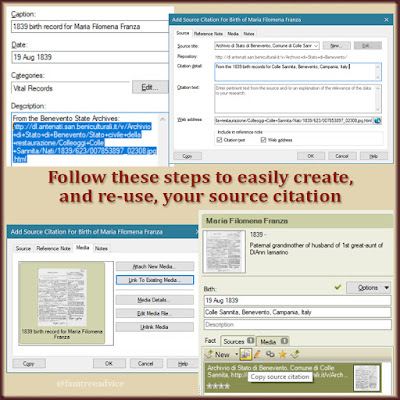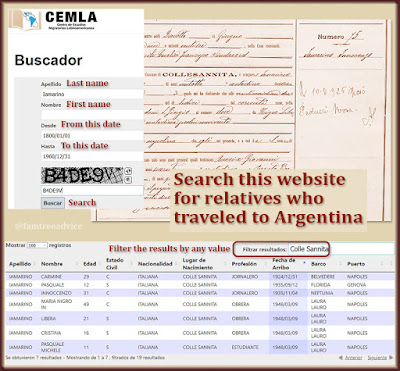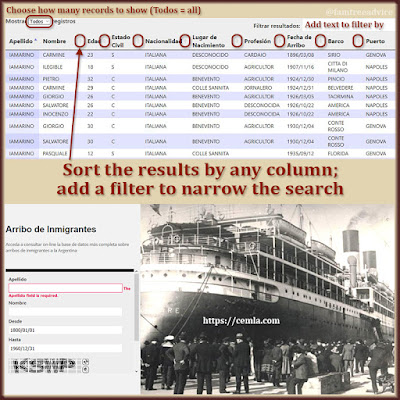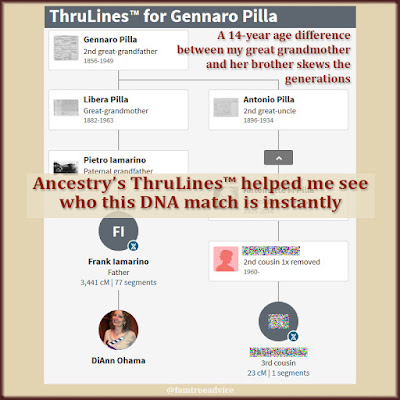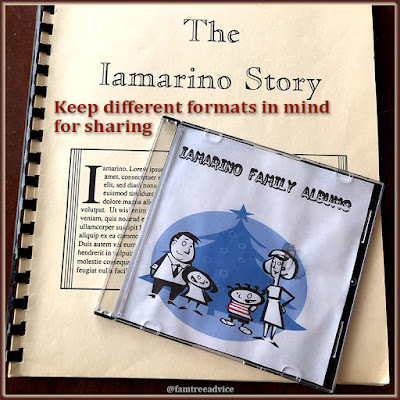Sometimes a rabbit hole is well worth the tumble.
I let a mistake guide my research this past Sunday. I must have been enjoying myself because I managed to forget it was my wedding anniversary. Again.
Here's what happened. I was randomly choosing people in my family tree and checking if they had good source citations. I want to bring all my source citations up to my new standards. I was working on my 2nd great uncle, Giuseppantonio Iamarino, who has a bunch of U.S. documents.
Then I noticed an error. He had arrived in America in 1903 and I had his 1920 census. But I'd also attached an immigration record from 1920—a few months after the census. That couldn't be him, could it?
I checked the facts on the ship manifest. The name and age were a match, and it mentioned his wife Libera back in his hometown. Aside from the date, the only fact that didn't fit my uncle was his destination: Girard, Ohio. My 2nd great uncle never left New York City.
 |
| If the document facts don't fit your person, what do you do? |
Who was the Giuseppantonio Iamarino on this ship manifest? Was it a coincidence that Girard, Ohio, is where my great grandfather lived? And where my father was born?
I turned to my collection vital records from Colle Sannita, Italy. I needed to find a Giuseppantonio Iamarino, born around 1876, who married a woman named Libera. There was only one good candidate, and he was not in my family tree.
Giuseppe Antonio Iamarino, born on 10 Jan 1876, was the son of Salvatore Iamarino and Costanza Nigro. Giuseppe's father was 30 years old at the time, so I jumped to the 1846 birth records.
I found Salvatore Iamarino's birth record. When I saw the names of his parents, I found they were already in my tree. His father, Giovannantonio Iamarino, is my 2nd cousin 5 times removed.
 |
| Anyone with that name definitely gets a spot in my family tree. |
The man from the wrongly attached 1920 ship manifest was my 4th cousin 3 times removed. The ship manifest says Giuseppantonio was going to Girard, Ohio, to join his cousin with the last name Piccirillo. I eventually found out Piccirillo is the last name of Giuseppantonio's mother-in-law.
What else could I find? Which other documents and names could I add to firm up this branch of my family tree? Giuseppantonio's 1876 birth record had 2 big clues for me:
- He married Liberantonia Nigro (the Libera from the ship manifest) on 12 Oct 1899 in Colle Sannita.
- He married Maria Teresa Mutino on 8 August 1935 in Colle Sannita.
I'm very familiar with my Italian document collections. I knew that the 1899 marriage record would not be available. But, since Liberantonio died between 1920 and 1935, I could find her death record. It would tell me her age and her parents' names. Then I could find her birth record and her parents' marriage record.
I could find the 1935 marriage record for Giuseppantonio and Maria Teresa Mutino. That would tell me her parents' names so I could climb her family tree.
And then there were Giuseppantonio's parents, Salvatore and Concetta Nigro. Their marriage would not be in the document collection. But I found Concetta's 1937 death record. That gave me her age and parents' names. I discovered her full name was Maria Concetta Pasqualina Nigro. Her parents weren't in my tree yet, but her grandparents were.
I kept going. I searched for records for Concetta's grandparents, and I started seeing familiar names. Something strange was happening. Concetta (Salvatore Iamarino's wife) and Liberantonia (Giuseppantonio Iamarino's wife) were 1st cousins. Their fathers were brothers.
But wait. There's more! The father of these 2 brothers was Giuseppantonio Nigro. When his 1st wife died, he married Margherita Callara. They were in-laws. Giuseppantonio's daughter-in-law's mother was Margherita. And Margherita's son-in-law's father was Giuseppantonio.
This family tree branch just turned into a pretzel!
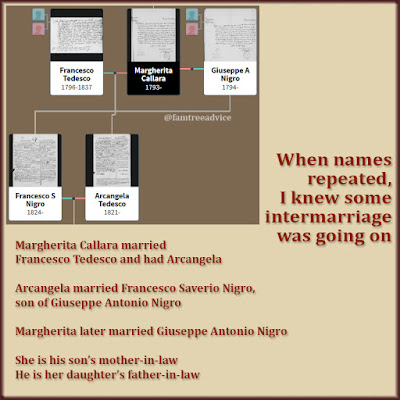 |
| Just when I thought I'd make a terrible mistake, I realized what was going on in this family. |
My little mission to find the man on a ship manifest added dozens of people to my family tree. They each opened more avenues to explore. Giuseppantonio's (from the ship manifest) 2nd wife had 2 husbands before him. Remember that this pre-1970s Italy. You remarried only after your spouse died.
She buried her 1906 husband and her 1909 husband before marrying Giuseppantonio Iamarino. She and her 2 previous husbands open up many more exploration routes. It's time to get all "Lewis and Clark" on them.
I believe I can take nearly anyone from these old vital records and find them a place in my family tree. I want to keep exploring these new avenues. Which personal milestone or national holiday will I forget this time?


